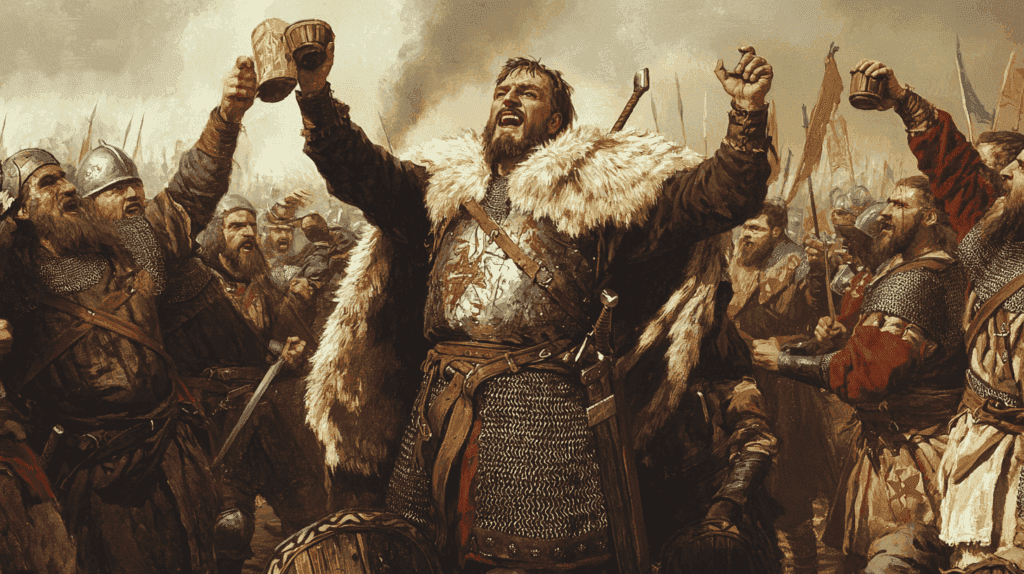
The emergence of the Kingdom of Poland under Duke Mieszko I in the 10th century marks a pivotal moment in European history, laying the foundation for a powerful state that would shape the geopolitical landscape of Central Europe for centuries to come.
The Early Polish State
The story of Poland’s emergence begins with the West Slavic tribes that inhabited the lands between the Oder and Vistula rivers. Among these tribes, the Polans, centered around the fortified settlement of Gniezno, played a crucial role in the formation of the Polish state. It was from this tribe that Mieszko I, a member of the Piast dynasty, would rise to power and unite the Polish lands.
Mieszko I, born around 935, was the son of Siemomysł and grandson of Lestek. He ascended to power around 960, inheriting a nascent state that was still in the process of consolidation. The exact circumstances of his early rule are shrouded in legend, with some chronicles suggesting that he was blind until the age of seven – a detail that is likely allegorical rather than factual.
The Early Campaigns: Consolidation of Power
When Mieszko ascended to power around 960 CE, he inherited the tribal state of the Polans in the region of Greater Poland, centered around the strategic stronghold of Gniezno. His early campaigns were directed at unifying the surrounding tribes, such as the Masovians, Kuyavians, and Silesians. This unification was not only a matter of territorial expansion but also of creating a centralized authority capable of resisting external threats. The exact chronology of these campaigns remains unclear, but archaeological evidence suggests the construction of fortified settlements, indicating the systematic incorporation of new territories.
Mieszko’s efforts brought him into conflict with the Veleti, a powerful Slavic confederation to the west. The Veleti controlled significant trade routes and posed a threat to Mieszko’s growing state. By the mid-960s, Mieszko’s forces had clashed with the Veleti, achieving victories that secured the western borders of his realm. These early successes demonstrated Mieszko’s ability to command large armies and navigate the complexities of tribal politics.

The Conflict with the Germans
Mieszko’s western frontier faced constant pressure from the expanding Holy Roman Empire under the Ottonian dynasty. In 963, German forces led by Wichmann the Younger, a rebellious Saxon noble, launched raids into Polish territory. Though initially successful, Wichmann’s campaigns were ultimately repelled by Mieszko, who demonstrated his resilience against a more technologically advanced enemy.
To counter the German threat, Mieszko adopted a strategy of alliance and submission. In 965, he married Dobrawa, a Bohemian princess and a Christian, thereby forging an alliance with the Duchy of Bohemia. The following year, Mieszko converted to Christianity, a decision with profound military and political implications. His baptism aligned Poland with the Christian West, providing a measure of protection against German aggression, as it became politically untenable for Christian rulers to wage war against a fellow Christian state.

Mieszko’s newfound alliance with the Church also facilitated the incorporation of Poland into the broader European diplomatic network. In 967, with support from Bohemian troops, Mieszko defeated Wichmann decisively, ending the Saxon raids. This victory solidified his control over the western territories and bolstered his reputation as a capable leader.
The War with the Wolin and Pomeranians
By the late 960s, Mieszko turned his attention northward, toward the Baltic coast. The Pomeranians, a group of pagan tribes inhabiting the region, controlled critical trade routes along the Oder River and access to the lucrative Baltic trade. Mieszko’s campaign against the Pomeranians began in earnest around 967 and continued intermittently for several years.
These campaigns were characterized by fierce resistance from the Pomeranians, who relied on their well-fortified settlements and naval capabilities. Mieszko’s strategy involved a combination of siege warfare and the construction of his own fortified outposts to secure newly conquered territories. By the early 970s, Mieszko had subdued much of Pomerania, extending his control to the Baltic Sea. This conquest not only enhanced Poland’s economic prospects but also increased its strategic importance in the region.
Mieszko’s efforts to Christianize the Pomeranians were less successful, as the region remained a hotbed of pagan resistance for decades. Nevertheless, his campaigns laid the groundwork for future Polish rulers to consolidate their hold over the Baltic coast.
The Battle of Cedynia (972)
One of Mieszko’s most celebrated military achievements occurred in 972 at the Battle of Cedynia. The clash was the culmination of tensions with the Holy Roman Empire, specifically with Margrave Odo I of the Saxon Eastern March. Odo, seeking to curtail Mieszko’s growing influence, launched an incursion into Polish territory.
Mieszko’s forces, numbering approximately 4,000, faced a larger and better-equipped German army. Demonstrating his tactical acumen, Mieszko lured Odo’s forces into a trap near the town of Cedynia. The Polish army, which included a contingent led by Mieszko’s brother Czcibor, ambushed the Germans from multiple sides, leveraging the terrain to negate their numerical advantage. The ensuing battle was a resounding victory for Mieszko, solidifying his control over the western border and enhancing his prestige in the eyes of both allies and enemies.

The Battle of Cedynia also had significant diplomatic repercussions. Emperor Otto I, wary of escalating the conflict, opted for a negotiated settlement rather than further military action. This outcome underscored Mieszko’s ability to balance military strength with diplomatic pragmatism.
Campaigns in Lesser Poland and Silesia
Mieszko’s southern campaigns focused on the regions of Lesser Poland and Silesia, which were vital for securing trade routes and establishing a contiguous realm. The annexation of Lesser Poland, including the key city of Kraków, likely occurred in the mid-970s. This acquisition brought Mieszko into conflict with the Bohemians, his former allies. But by the early 980s, Mieszko had successfully wrested control of Silesia from Bohemian influence, further expanding his domain.
In the later years of his reign, Mieszko turned his attention eastward, toward the territories of the Kievan Rus’. While the exact details of these campaigns are scant, it is evident that Mieszko sought to assert Polish influence over the borderlands and secure his eastern frontier. His efforts likely included both military action and diplomatic maneuvers aimed at countering the influence of competing powers such as Bohemia and the Rus’.
Diplomatic Maneuvering
Mieszko I’s reign was characterized by skillful diplomacy. He formed alliances with Bohemia, Sweden, and the Holy Roman Empire, often shifting allegiances as the political situation demanded. His ability to navigate the complex web of European politics was crucial in maintaining Polish independence and furthering its interests.
One of Mieszko’s most significant diplomatic achievements was his relationship with the Holy Roman Empire. By aligning himself with the Empire, Mieszko gained a powerful ally against the pagan Veleti tribes that threatened Poland’s western borders. This alliance also provided legitimacy to Mieszko’s rule in the eyes of other Christian monarchs.

Cultural and Religious Transformation
The adoption of Christianity had profound effects on Polish culture and society. It brought Poland into the sphere of Western Christian civilization, introducing Latin as the language of administration and liturgy. This cultural shift facilitated Poland’s integration into the broader European community and provided access to new ideas and technologies.
The Church played a crucial role in the development of the Polish state. It provided a framework for administration, education, and law. Monasteries became centers of learning and culture, preserving knowledge and introducing new agricultural techniques.

Legacy and Succession
Mieszko I’s reign laid the groundwork for the Kingdom of Poland. Although he never took the title of king himself, preferring to style himself as “Duke of the Poles,” his son Bolesław I the Brave would become the first crowned King of Poland in 1025. This dynasty would continue to rule Poland for centuries, overseeing its transformation from a loose confederation of tribes to a powerful medieval kingdom.
Under Mieszko’s successors, particularly his son Bolesław I the Brave, Poland would continue to expand and consolidate its power. The kingdom would face periods of fragmentation and reunification, but the foundations laid by Mieszko I would prove enduring.
Mieszko’s legacy extended beyond Poland’s borders. His daughter, Świętosława (also known as Sigrid the Haughty), became a queen of the Vikings and the grandmother of Cnut the Great, king of England, Denmark, and Norway. This connection illustrates the far-reaching impact of Mieszko’s dynastic policies.





What a wonderful article. I learned so much and it was explained so well.